| |
|
Xiamen Oil Paintings, Wholesale Direct!
|
|
100% hand painted, 100% cotton canvas, 100% money back if not satisfaction. |
|
|
|
|
ART WORKS INDEX
A
B
C
D
E
F
G
H
I
J
K
L
M
N
O
P
Q
R
S
T
U
V
W
X
Y
Z
|
|
ARTISTS INDEX
A
B
C
D
E
F
G
H
I
J
K
L
M
N
O
P
Q
R
S
T
U
V
W
X
Y
Z
|
|
|
|
|
|
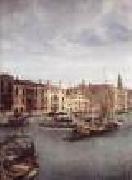 |
MARIESCHI, Michele
|
|
Italian Painter, 1710-1743
Italian painter and engraver. His first biographers, Orlandi and Guarienti (1753), stated that Marieschi worked in Germany early in his career and then returned to Venice, where he established himself as a painter of 'beautiful views of the Grand Canal, and of churches and palaces'. Yet there is no other evidence for this journey and Marieschi's early training remains problematic. It seems likely that he began his career as a stage designer: his first recorded activity, in 1731, was the preparation, on behalf of the impresario Francesco Tasso ( fl 1725-c. 1740), of the setting for the Venetian celebration of Carnival Thursday in the Piazzetta. He then, influenced by Marco Ricci and Luca Carlevaris, began to paint capriccios and vedute. His early capriccios, such as the pair Capriccio with Classical Ruins and Bridge and Capriccio with Roman Arch and Encampment (mid-1730s; Naples, Mus. Civ. Gaetano Filangieri), are indebted to Ricci, although they lack his solemnity and magnificence. Marieschi's blend of medieval and Classical ruins in a serene Venetian landscape is more picturesque and romantic. Marieschi began to paint vedute having been encouraged by Canaletto's great success with the genre; examples such as the S Maria della Salute (1733-5; Paris, Louvre), the Piazzetta dei Leoni and the Grand Canal at Ca' Pesaro (1734-5; both Munich, Alte Pin.) are distinguished from Canaletto's work by their exaggerated perspective, more atmospheric colour and the spirited handling of the small figures. Two capriccios, the Town on a River with Rapids (London, N.G.) and the Town on a River with Shipping (London, N.G.;.), both charmingly picturesque scenes with watermills and crumbling towers, date from the mid-1730s. Marieschi began to etch in the 1730s,
|
|
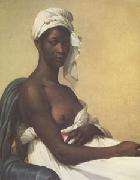 |
Marie-Guillemine Benoist
|
|
Paris 1768-1826
was a French neoclassical, historical and genre painter. She was born in Paris, the daughter of a civil servant. Her training as an artist began in 1781 under Élisabeth Vigee Le Brun, and she entered Jacques-Louis David's atelier in 1786 along with her sister Marie-Élisabeth Laville-Leroux. The poet Charles-Albert Demoustier, who met her in 1784, was inspired by her in creating the character Émile in his work Lettres Émilie sur la mythologie (1801). In 1791 she exhibited for the first time in the Salon de Paris, displaying her mythology-inspired picture Psych faisant ses adieux sa famille. Another of her paintings of this period, L'Innocence entre la vertu et le vice, is similarly mythological and reveals her feminist interests in this picture, vice is represented by a man, although it was traditionally represented by a woman. In 1793, she married the lawyer Pierre-Vincent Benoist. Her work, reflecting the influence of Jacques-Louis David, tended increasingly toward history painting by 1795. In 1800, she exhibited Portrait d'une negresse in the Salon. Six years previously, slavery had been abolished, and this image became a symbol for women's emancipation and black people's rights. This picture was acquired by Louis XVIII for France in 1818. An important commission, for a full-length portrait of Napol on Bonaparte Premier Consul Français in this period was awarded to her in 1803. This portrait was to be sent to the city of Ghent, newly ceded to France by the Treaty of Luneville in 1801. Other honors came to her; she was awarded a Gold Medal in the Salon of 1804, and received a governmental allowance. During this time she opened an atelier for the artistic training of women. Her career was harmed by political developments, however, when her husband, the convinced royalist count Benoist, was nominated in the Conseil d'État during the post-1814 monarchy come-back called the Bourbon Restoration.
|
|
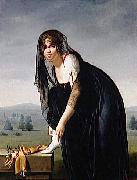 |
Marie-Denise Villers
|
|
(1774 - August 19, 1821) was a French painter, who specialized in portraits. She was born Marie-Denise Lemoine in Paris. She came from an artistic family, and her sisters Marie-Victoire Lemoine and Marie-Élisabeth Gabiou were also accomplished artists. In 1794, Marie-Denise married an architecture student, Michel-Jean-Maximilien Villers.
Villers was a student of the French painter Anne-Louis Girodet de Roussy-Trioson. She was first exhibited at the Paris Salon of the Year VII (1799). Villers' most famous painting, Young Woman Drawing,
|
|
|
|
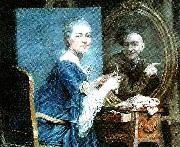 |
marie suzanne giroust roslin
|
|
Marie-Suzanne Giroust, född 9 mars 1734 i Paris, Frankrike, död 31 augusti 1772 i Paris, var en fransk konstnär, i huvudsak verksam inom pastellmåleri. Hon var gift med den svenske porträttmålaren Alexander Roslin från 1759 till sin död.
Dotter till Barthelemy Giroust och Marie Suzanne Leroy. När Giroust var sju år gammal, dog hennes far som var juvelerare. Fyra år senare dog även hennes mor, och hon flyttade in hos släktingar. Arvet efter fadern gav henne möjlighet att uppta målarstudier. Hon inledde sina studier hos Maurice Quentin de La Tour, men det var hos Joseph-Marie Vien hon kom att finna sig tillrätta. I Viens atelj?? träffade hon 1752 Alexander Roslin och blev förälskad. Girousts förmyndare kunde dock inte acceptera den svenske målaren som blivande make, då han var fattig och protestant.[1] Paret kämpade för sin kärlek, och Giroust vägrade att träffa de friare som hennes förmyndare föreslog för henne.[1] Efter medling av bland andra Roslins vän och beskyddare, Comte de Caylus, kunde Roslin och Giroust gifta sig, den 5 januari 1759. Paret Roslin fick mellan 1760 och 1772 sex barn, tre döttrar och tre söner, varav två döttrar och två söner nådde vuxen ålder.
Alexander Roslin erkände offentligen sin hustrus talang som konstnär, och han hävdade att hon var en skickligare pastellmålare än han själv. Giroust invaldes 1770 i den franska konstakademin, Acad??mie royale. 1771 utställde hon sitt porträtt av abb?? Lemonnier, som fick mycket beröm. Hon måladet i pastell.
Marie-Suzanne Giroust avled i bröstcancer i slutet av augusti 1772.
|
|
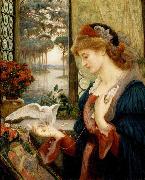 |
Marie Spartali Stillman
|
|
English Pre-Raphaelite Painter, 1844-1927
was a British Pre-Raphaelite painter of Greek descent, arguably the greatest female artist of that movement. During a sixty-year career she produced over one hundred works, contributing regularly to galleries in Great Britain and the United States. Maria Spartali was the youngest daughter of Michael Spartali, a wealthy merchant and Greek consul-general based in London, and his wife Euphrosyne. She and her cousins Maria Zambaco and Aglaia Coronio were known collectively among friends as "the Three Graces", after the Charites of Greek mythology (Aglaia, Euphrosyne and Thalia), as all three were noted beauties of Greek heritage. Swinburne said of Spartali: "She is so beautiful that I want to sit down and cry". Spartali studied under Ford Madox Brown for several years from 1864, with his children Lucy, Catherine and Oliver. She modelled for: Brown; Burne-Jones (The Mill); Julia Margaret Cameron; Rossetti (A Vision of Fiammetta, Dante's Dream, The Bower Meadow); Spencer Stanhope; and Whistler (La Princesse du Pays de la Porcelaine). In 1871, against her parents' wishes, she married American journalist and painter William J. Stillman. She was his second wife, his first having committed suicide two years before. His job as a foreign correspondent resulted in the couple dividing their time between London and Florence from 1878 to 1883, and then Rome from 1889 to 1896.
|
|
 |
Marie Laurencin
|
|
French Painter, ca.1885-1956
French painter, stage designer and illustrator. After studying porcelain painting at the Sevres factory (1901) and drawing in Paris under the French flower painter Madelaine Lemaire (1845-1928), in 1903-4 she studied at the Academie Humbert in Paris, where she met Georges Braque and Francis Picabia. In 1907 she first exhibited paintings at the Salon des Independants, met Picasso at Clovis Sagot gallery and through Picasso was introduced to the poet Guillaume Apollinaire. Laurencin and Apollinaire were soon on intimate terms, their relationship lasting until 1912.
|
|
 |
marie kroyer
|
|
(efter 1912 Alfven), född Triepcke 11 juni 1867 i Köpenhamn, död 25 maj 1940 i Stockholm, var en dansk konstnär, bosatt i Sverige från cirka 1905.
Marie Krøyer var 1889-1905 gift med konstnären Peder Severin Krøyer och hamnade i skuggan av hans konstnärskap. Själv kom hon att uppmärksammas som konstnär långt efter sin död. Hon levde ihop med den svenske tonsättaren Hugo Alfv??n från 1905 då de fick dottern Margita tillsammans; de gifte sig 1912 och skildes 1936 efter en lång rättsprocess. Paret var bosatta i Uppsala och Leksand. Marie hade också dottern Vibeke med Krøyer.
|
|
 |
Marie Ellenrieder
|
|
Anna Marie Ellenrieder (March 20, 1791 - June 5, 1863, Konstanz) was a German painter.
She was born in Konstanz, Germany, the daughter of Konrad and Anna Maria Herrmann, and the granddaughter of Franz Ludwig Herrmann.
She studied under the miniature painter Joseph Einsle. Her portraits, similar in style to the ones of Angelica Kauffmann, made her the first woman to enter the Academy of Fine Arts Munich.
She spent the time between 1822 and 1824 in Rome, where she became a disciple of Friedrich Johann Overbeck. After this journey, she started painting religious topics such as "Christ Blessing Little Children" and "Mary and the Infant Jesus." Her two paintings "Der 12 jährige Jesus im Tempel / The 12 year old Jesus in the Temple", 1849 (oil on canvas, 203,2 x 139,7 cm) and "Hl Felicitas und ihre sieben Söhne / Holy Felicitas and her Seven Sons", 1847 (oil on canvas, 127 x 177,8 cm) were acquired by Queen Victoria who had been introduced to her work by the Prince Consort, who in turn had encountered the artist on his travels to Rome. They are now part of the Royal Collection in Osborne House.
She died in her home town of Konstanz.
|
|
|
|
|
|
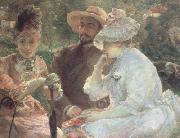 |
Marie Bracquemond
|
|
French Impressionist Painter, 1840-1916
.was a French Impressionist artist described by Gustave Geffroy in 1894 as one of the "le trois grandes dames" of Impressionism alongside Berthe Morisot and Mary Cassatt.However, her often omission from books on women artists indicate the success of her husband, F??lix Bracquemond, in his campaign to thwart her development as an artist.
|
|
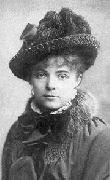 |
Marie Bashkirtseff
|
|
(Russian: November 11, 1858 October 31, 1884) was a Ukrainian-born Russian diarist, painter and sculptor.
Marie BashkirtseffBorn Maria Konstantinovna Bashkirtseva in Gavrontsy near Poltava, to a wealthy noble family, she grew up abroad, traveling with her mother across most of Europe. Educated privately, she studied painting in France at the Acad??mie Julian, one of the few establishments that accepted female students. The Acad??mie attracted young women from all over Europe and the United States. One fellow student was Louise Breslau who Marie viewed as her only rival. Marie would go on to produce a remarkable body of work in her short lifetime, the most famous being the portrait of Paris slum children titled The Meeting and In the Studio, (shown here) a portrait of her fellow artists at work. Unfortunately, a large number of Bashkirtseff's works were destroyed by the Nazis during World War II.
From the age of 13, she began keeping a journal, and it is for this she is most famous. Her personal account of the struggles of women artists is documented in her published journals, which are a revealing story of the bourgeoisie. Titled, I Am the Most Interesting Book of All, her popular diary is still in print today. The diary was cited by an American contemporary, Mary MacLane, whose own shockingly confessional diary drew inspiration from Bashkirtseff's. Her letters, consisting of her correspondence with the writer Guy de Maupassant, were published in 1891.
The grave of Marie BashkirtseffDying of tuberculosis at the age of 25, Bashkirtseff lived just long enough to become an intellectual powerhouse in Paris in the 1880s. A feminist, in 1881, using the nom de plume "Pauline Orrel," she wrote several articles for Hubertine Auclert's feminist newspaper, La Citoyenne. One of her famous quotes is: Let us love dogs, let us love only dogs! Men and cats are unworthy creatures.
|
|
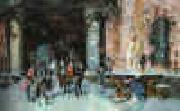 |
Mariano Fortuny y Marsal
|
|
1838-1874
Spanish
Mariano Fortuny y Marsal Gallery
He was born in Reus, a town near Taragona in the autonomous community of Catalonia in Spain. His father died when he was an infant, his mother by age 12, thus Mariano was raised by his grandfather, a cabinet-maker. His grandfather taught him to make wax figurines. At the age of 9, at a public competition in his town a local patron, Domingo Soberno, encouraged further study. At the age of 14 years he moved to Barcelona with his grandfather. A sculptor, Domingo Taleru, secured him a pension of to allow him to attend the Academy of Barcelona. There he studied for four years under Claudio Lorenzale, and in March of 1857 he gained a scholarship that entitled him to two years of studies in Rome starting in 1858. There he studied drawing and grand manner styles.
In 1859, he was called by the Spanish government to depict the campaigns of the Spanish-Moroccan War. The expedition lasted for only about six months, and he returned to Spain in the summer of 1860.
The battle of Tetuan by Mariano Fortuny (1863-73)Since the days of Velazquez, there had been a tradition in Spain of memorializing battles and victories in paint; and on the basis of his experiences, Fortuny was commissioned by the city of Barcelona to paint a large canvas diorama of the capture of the camps of Muley-el-Abbas and Muley-el-Hamed by the Spanish army. He began his composition of The battle of Tetuan on a canvas fifteen metres long; but though it worked on and off on it during the next decade, he never finished it.
The greater influence of this travel on Fortuny was his subsequent fascination with the exotic themes of the world of Morocco, painting both individuals and imagined court scenes. He visited Paris in 1868 and shortly afterwards married Cecilia de Madrazo, the daughter of Federico Madrazo, who would become curator of the Prado Museum in Madrid. Together, they had a son, Mariano Fortuny y Madrazo, who became a well-known fashion and tapestry designer. Another visit to Paris in 1870 was followed by a two years' stay at Granada, but then he returned to Rome, where he died somewhat suddenly on the 21st of November 1874 from an attack of tertian ague, or malaria , contracted while painting in the open air at Naples and Portici in the summer of 1874.
Fortuny paintings are colorful, with a vivacious iridescent brushstroke, that at times recalls the softness of Rococo painting but also anticipates impressionist brushwork, Fortuny??s recollection of Morocco is not a costume ball, but a fierce, realistic portrait which includes bare-chested warriors. Richard Muther states:
??his marvellously sensitive eye ?? discerned the stalls of Moorish carpet-sellers, with little figures swarming, and the rich display of woven stuffs of the East; the weary attitude of old Arabs sitting in the sun; the sombre, brooding faces of strange snake-charmers and magicians. This is no Parisian East??every one here speaks Arabic??.
Fortuny often painted scenes where contemporary life had still not shaken off the epaulets and decorations of ancient traditions such a the ????Burial of a matador???? and couples signing marriage contracts (La Vicaria). Each has the dazzle of bric-a-brac [1]ornament, but as in his painting of the ????Judgement of the model????, that painterly decorative air of Rococo and Romanticism was fading into academicism and left to confront the naked reality of the represented object. He inherited Goya??s eye for the paradox of ceremony and reality.
|
|
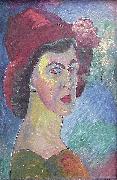 |
Marianne von Werefkin
|
|
Marianne von Werefkin (Russian, 10 September 1860, Tula, Russia - 6 February 1938, Ascona, Switzerland), born Marianna Wladimirowna Werewkina (transliteration Marianna Vladimirovna Verevkina), was a Russian-Swiss Expressionist painter.
Marianne von Werefkin was born the daughter of the commander of the Ekaterinaburg Regiment. In 1880, she became a student of Ilya Repin, the most important painter of Russian Realism. Her progress was dealt a setback by a hunting accident in 1888 in which she shot her right hand, the one with which she painted.
In 1892 she met Alexej von Jawlensky, who desired to be her protege, and in 1896 she, Jawlensky, and their servant moved to Munich. For the sake of Jawlensky's painting, Werefkin interrupted her painting for almost ten years.
She created her first expressionist works in 1907. In these she followed Paul Gauguin's and Louis Anquetin's style of "surface painting", while also showing the influence of Edvard Munch. In 1909, the Neue Kenstlervereinigung Menchen (New Association of Artists in Munich, NKVM) was founded. It became a forum of exhibitions and programming.
At the outbreak of the First World War, they immigrated to Switzerland, near Geneva. They later moved to Zurich. By 1918, they had separated, and Werefkin moved alone to Ascona, on Lago Maggiore. In 1924 she founded the artist group "Grober Bar" (i.e., Big Bear, Ursa Major).
|
|
 |
Marianne Stokes
|
|
(1855 Graz, Styria - August 1927 London), born Marianne Preindlsberger in the Austrian province of Styria, was an Austrian painter. She settled in England after her marriage to Adrian Scott Stokes (1854-1935), the landscape painter, whom she had met in Pont-Aven. Marianne Stokes was considered one of the leading artists in Victorian England.
Preindlsberger first studied in Munich under Lindenschmidt and having been awarded a scholarship for her first picture, 'Muttergluck', she worked in France under Pascal Adolphe Jean Dagnan-Bouveret (1852-1929), Colin and Gustave Courtois (1853-1923). She painted in the countryside and Paris, and, as with many other young painters, fell under the spell of the rustic naturalist Jules Bastien-Lepage. Her style continued to show his influence even when her subject matter changed from rustic to medieval romantic and biblical. While in France she met the Finnish painter Helene Schjerfbeck, in whose company she visited Pont-Aven in 1883.
Her first salon painting, 'Reflection', which had been painted in Brittany, was exhibited in 1885 at the Royal Academy. Her work was also shown at the Grosvenor Gallery, New Gallery, and the Society of British Artists and in 1885, a year after her marriage, she took to using the name 'Mrs. Adrian Stokes'. She held a joint exhibition with her husband at the Fine Art Society in 1900. The Stokes' lived in St Ives where Marianne was a member of the Newlyn School. Having no children, they regularly travelled abroad, frequently to the Tyrol, and in 1905 to Slovakia and the High Tatra. Here they spent about half a year sketching and painting in the villages of Važec, Mengusovce and Ždiar. Adrian Stokes concentrated on landscapes with images of hay-harvesting and picturesque cottages, while Marianne Stokes painted portraits showing fine detail of the garments. These paintings provide a valuable record of the Slovak culture.
After abandoning oils, and inspired by the Pre-Raphaelite movement, she painted flat compositions in tempera and gesso, her paintings giving the impression of being frescoes on plaster surfaces. She was an Associate of the Royal Society of Painters in Water Colours.
|
|
 |
Marianne North
|
|
(24 October 1830 - 30 August 1890), English naturalist and flower-painter, was born at Hastings, the eldest daughter of a Norfolk landowner, descended from Roger North.
|
|
|
|
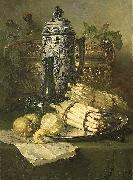 |
Maria Vos
|
|
painted Stilleven met kan van steengoed in 1878
|
|
 |
Maria Sibylla Merian
|
|
German Baroque Era Illustrator, 1647-1717,Daughter of Mattheus Merian. After her father's death, her mother married in 1651 the flower still-life painter Jacob Marell, who became Maria Sibylla's teacher. On 16 May 1665 she married Johann Andreas Graff, another pupil of her stepfather. She thenceforth specialized in illustrations of flowers, fruit and, especially, grubs, flies, gnats and spiders. In 1670 the family moved to Nuremberg. In 1675 Sandrart referred to her in the Teutsche Academie, reporting that she painted on cloth (i.e. silk, satin). With Graff, she produced a book of flowers, the first part appearing in 1675; a second edition, enlarged by parts 2 and 3 ,came out in 1680, entitled Florum fasciculi tres. It included 36 engravings intended to serve as patterns for embroidery.
|
|
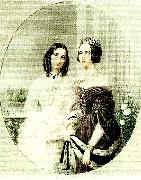 |
maria rohl
|
|
Maria Christina Röhl, född i Stockholm den 26 juli 1801, död i Klara församling, Stockholm den 5 juli 1875, var en svensk porträttmålare som avbildade ett flertal samtida kända personer. Medlem i konstakademien (1843) och hovleverantör. Hennes tavlor hänger bland annat på Nationalmuseum i Stockholm. En samling av 1800 porträtt finns på Kungliga Biblioteket.
Maria Röhl växte upp i en rik familj, men då hon blev föräldralös 1822 drabbades hon av fattigdom. Hon tänkte först bli guvernant, men professorn och kopparstickaren Christian Forsell undervisade henne då i teckning; hon hade redan tidigare undervisats av målaren Alexander Hambr??, och fick nu lära sig att utföra snabba och realistiska porträtt i blyerts; hon arbetade i blyerts och krita i svartvitt.
Hon bodde hos familjen Forsell, där hon först avbildade familjens vänner och sedan, då det hade blivit modernt att låta avbilda sig av "mamsell Röhl", försörjde hon sig på detta i trettio år. Hon utnämndes till kunglig hovmålare 1843, studerade 1843-1846 under Leon Cogniet vid Franska konstakademien i Paris och hade sedan en atelj?? i Brunkebergs hotell i Stockholm. Fotografikonsten blev en svår konkurrent under hennes sista år. Även systern Eva Röhl (1810-96) uppges ha haft viss konstärlig begåvning.
|
|
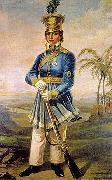 |
Maria Quiteria
|
|
(1792-1853) was a Brazilian Lieutenant and national heroine. She served in the Brazilian war of independence in 1822-23 dressed as a man. She was promoted to cadet and Lieutenant and decorated with the Imperial order. She has been called "Brazilian Joan of Arc".
|
|
|
|
|
|
|
|
|
|
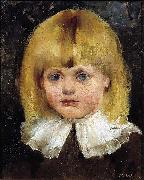 |
Maria Catharina Wiik
|
|
(b Helsinki, 2 Aug 1853; d Helsinki, 19 June 1928). Finnish painter. She studied in Paris at the Academie Julian from 1875 to 1876 under Tony Robert-Fleury and continued her studies with him in the same studio between 1877 and 1880. Her paintings appeared at the Salon for the first time in 1880 (e.g. Marietta, 1880; Helsinki, priv. col., see Katerma, p. 31). The realist techniques Wiik absorbed in Paris came to form the basis of her work, tranquil in composition and restrained in colour. Her favourite subjects were relatively small-scale portraits such as Hilda Wiik (1881; Helsinki, Athenaeum A. Mus.) and still-lifes (e.g. Still-life, c. 1880; Helsinki, Athenaeum A. Mus.). Like many other foreign painters Wiik went to Brittany to paint. In 1883-4 she worked in Concarneau and Pont-Aven, where her enthusiasm for plein-air painting brought immediacy to her work and greater brightness to her colours (e.g. Breton Farm, 1883; Naantali, Fereningen Hedvigsminne). She preferred to record her impressions in portraits, although she also painted small, light-filled landscapes. In 1889 Wiik worked under the direction of Puvis de Chavannes in Henri Bouvet's studio in Paris, and in the same year she visited St Ives where she painted, among others, two major works: Out in the World (Helsinki, Athenaeum A. Mus.) and the St Ives Girl (Helsinki, priv. col., see Katerma, p. 93). Both works show Wiik moving towards an ever more internalized and minimal mode of expression, thereby taking part in the process that led, in the 1890s, to a general abandonment of realism in favour of a greater emphasis on emotion. Out in the World, which shows an old woman's sad parting from a young girl who is leaving home to begin work, shows a change in technique with the use of more united colour surfaces and of tone painting. (This work was awarded a bronze medal at the Exposition Universelle in Paris in 1900.) During the 1890s and the early 20th century Wiik's travels were concentrated in Scandinavia, although she visited Paris in 1905.
|
|
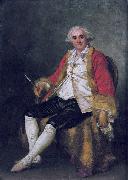 |
Marguerite Gerard
|
|
Marguerite Gerard (28 January 1761 in Grasse - 18 May 1837 in Paris) was a French painter and etcher. She was the daughter of Marie Gilette and perfumer Claude Gerard. At 8 years-old she became the sister-in-law of Jean-Honore Fragonard, and when she was 14 she became his pupil, and she often worked with him. She was also the aunt of the artist Alexandre-Évariste Fragonard.
|
|
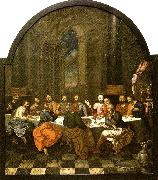 |
margareta capsia gavelin
|
|
Margareta Capsia, född 1682 i Sverige, död 20 juni 1759 i Åbo, var en svensk-finländsk konstnär, den första kvinnliga konstnären i Finland och en av de första i Skandinavien. Hon var kyrkomålare och målade altartavlor, men utförde även personporträtt.
Capsias föräldrar Gottfried Capsia och Anna Schultz hade kommit till Sverige från Holland. Hon gifte sig i Stockholm 1719 med prästen Jacob Gavelin och flyttade till Vasa 1721, där hon gjorde sig känd som altarmålare i Österbotten. 1730 flyttade paret till Åbo, där hon blev känd i hela landet som konstnär. Hon målade altatavlorna i en rad kyrkor, bla målade hon 1739 Säkylä kyrkas altartavla, och i den gamla kyrkan i Paltamo, den så kallade bildkyrkan, finns bland annat en altartavla från 1727 som föreställer nattvarden. Hennes altartavlor beskrivs som individualistiska och naivt ärliga bibelillustrationer, och hon ansågs som landets då främsta altarkonstnärer tillsammans med Mikael Toppelius.
Hon var en av de få kvinnliga konstnärerna kända i Skandinavien före 1800-talet, tillsammans med Ulrika Pasch i Sverige och Johanne Marie Fosie i Danmark. I Finland var även Helena Arnell känd under samma tid.
|
|
|
|
|
|
|
|
|
|
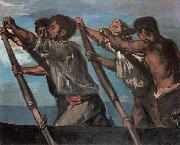 |
Marees, Hans von
|
|
German Painter, 1837-1887
was a German painter. He mainly painted country scenes in a realistic style. Von Mar??es was born in Elberfeld, Germany. At age 16, he was sent to the Berlin Academy. In 1857, he moved to Munich. In 1869, he visited France, the Netherlands and Spain. He served in the Franco-Prussian War (1870?C71) and then lived in Berlin and Dresden for a while. In 1873, he decorated the library walls of the newly built Naples Zoological Institute in Italy.
|
|
 |
Marcus Stone
|
|
British
1840-1921
English painter, son of Frank Stone, ARA, was trained by his father and began to exhibit at the Academy before he was eighteen; and a few years later he illustrated with much success books by Charles Dickens, Anthony Trollope, and other writers, friends of his family. He was elected an associate of the Royal Academy in 1877, and academician in 1887. In his earlier pictures he dealt much with historical incidents, but in his later work he occupied himself chiefly with a particular type of dainty sentiment, treated with much charm, refinement and executive skill.
|
|
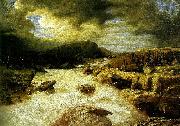 |
marcus larson
|
|
Simon Marcus Larson, född 5 januari 1825, Lilla Örsätter, Åtvidaberg, död 25 januari 1864 i London, var en svensk målare. Han tillhörde Dusseldorfskolan och skildrade naturens krafter på ett romantiskt och dramatiskt sätt. Larson hade en kort karriär och avled vid 39 års ålder, men ses ändå som en av Sveriges främsta 1800-talskonstnärer.
1856 var Larson i Dusseldorf och på julafton skissade han på ett solnedgångsmotiv vid den bohuslänska kusten, men Larson drömde om att måla en större tavla, hans atelje var alltför trång. Så en dag när han satt i stans populäraste caf?? och drack öl fick han id??n att han skulle måla i caf??lokalen. Sagt och gjort så hyrde han lokalen i 14 dagar. Duken han spände upp var 10-12 fot hög och 18 fot bred.
Efter 10 dagar var tavlan klar. Tavlan ställdes ut på akademien och det byggdes en utsiktsramp för att åskådarna skulle få en överblick över tavlan, priset var 5 Silbergroschen per titt och det annonserades att intäkterna skulle gå till välgörande ändamål, vilket fick stort uppseende, särskilt bland övriga konstnärer, utställningen varade mellan 25 jan. och 15 feb. 1857 Tavlan ställdes också ut bland annat i Köln och Berlin sedan till Salon Carre i Paris där den hyllades. Därefter ställdes den också ut i Stockholm där Larson tänkte skänka tavlan till staten tillsammans med köpet av Vattenfall i Småland, men då Larson på hösten inte fick sälja nämnda tavla tog han ned den stora tavlan och tog den med sig när han lämnade Sverige och fortsatte sina resor, han visade den under några år, sista gången någon skrivit om tavlan var 1863, Efter Larsons död i London försvann tavlan.
|
|
|
|
|
|
 |
Marco Ricci
|
|
(5 June 1676 - 1730) was an Italian painter of the Baroque period. He was the nephew of Sebastiano Ricci. After receiving his first instruction in art from his uncle, he visited Rome, where he was for some years occupied in drawing vedute.
Ricci was born at Belluno. In 1710 he came to England with his uncle, and his vedute of ruins and architecture (capricci) found many patrons. Marco Ricci etched several plates from his own designs, consisting of views and landscapes, with ruins and figures, including a set of twenty-three prints, entitled Varia Marci Ricci Pictoris priestantissimi experimenta ab ipsomet auctore inventa, delineata atque incisa, et a me Carolo Orsolini Veneto incisore in unum collecta, c. Anno 1730, Venetiis. He died in Venice.
|
|
|
|
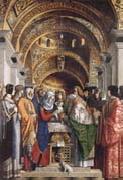 |
Marco Marziale
|
|
Italian Painter, active ca.1492-1507,Italian painter. He was first recorded in 1492 as one of several assistants to Giovanni Bellini in the Doge's Palace in Venice; in an inscription on his earliest known work, a damaged Virgin and Child with Saints and a Donor (1495; Zadar, St Mary, Treasury), he called himself a pupil of Gentile Bellini. Visual confirmation of his close association with both Bellini brothers is provided by the rather large number of his signed and dated works, many of which are closely based on compositional motifs by Giovanni, but which in their linearity and angularity more closely resemble the style of Gentile. The influence of German art, and of Derer in particular, has often been noted in the sharply focused and densely packed details, the harsh modelling and the expressive ugliness found in much of Marziale's work.
|
|
 |
Marcin Zaleski
|
|
was a Polish painter.
Zaleski was born in Krakew. Among his works was a series of paintings on the November Uprising in Warsaw, to which he was an eyewitness as well as numerous other paintings of the city. His work is featured in Turkey's Adam Mickiewicz Museum and the Gomel Palace, among other locations. He died in Warsaw.
|
|
|
|
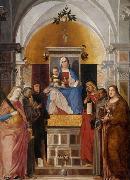 |
Marcello Fogolino
|
|
(active 1510-1548) was an Italian painter of the Renaissance or Mannerist style. Originally from the Friuli, he worked early in his life in Vicenza. Returning to Friuli in 1520-21, he came to reflect the painterly style of Il Pordenone. He completed a painting of Saints Francis and John the Baptist with Prophet Daniel for the Duomo in Pordenone. He was banished from Venice, for complicity in a murder in 1527, and went to Trento. He worked painting frescoes in the Tridentine region, including Castel Buonconsiglio, Castello Malpaga, Villa Salvotti, and Palazzo Sardagna.
|
|
 |
Marcello Bacciarelli
|
|
16 February 1731 - 5 January 1818) was an Italian painter of the late-baroque and Neoclassic periods.
He studied in Rome under Marco Benefial. In 1750 he was called to Dresden, Saxony, where he was employed by Elected King Augustus III of Poland; after whose death he went to Vienna, and thence to Warsaw. There he met and worked by the side of Italian painter in Dresden, Vienna and Warszawa , Bernardo Bellotto. He was the Director there of the new set up Academy of Arts of Warsaw.He painted a set of the Polish kings, from Boleslaus Chrobry downwards. That of Stanislaus II, Stanisław August Poniatowski has been engraved by A. de Marcenay de Ghuy, Kestner, and A. Fogg. Bacciarelli also painted scenes from the History of Poland. He died at Warsaw.
A number of his paintings were painted for King Stanisław August Poniatowski of Poland and are in the Royal Castle in Warsaw.
|
|
|
|
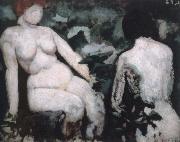 |
marcel duchamp
|
|
marche duchamp (1887 to 1968),French painter, sculptor and writer. The art and ideas of Duchamp, perhaps more than those of any other 20th-century artist, have served to exemplify the range of possibilities inherent in a more conceptual approach to the art-making process. Not only is his work of historical importance
|
|
|
|
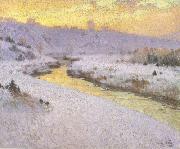 |
marc-aurele de foy suzor-cote
|
|
Canadian Painter, 1869-1937
was a Canadian painter and sculptor. He was born in Arthabaska, Quebec in 1869. He studied at the École des Beaux-Arts in Paris with L??on Bonnat during the 1890s. After his return to Quebec in 1908, he produced many impressionist paintings of the Quebec landscape, as well as portraits, nudes, historical paintings and later sculptures.
|
|
|
|
|
|
|
|
|
| Wholesale China Oil Painting Wholesale Oil Painting China Xiamen Portrait Reproduction on canvas Chinese Oil Painting Wholesale USA Oil Painting |
|
|
|
|
|